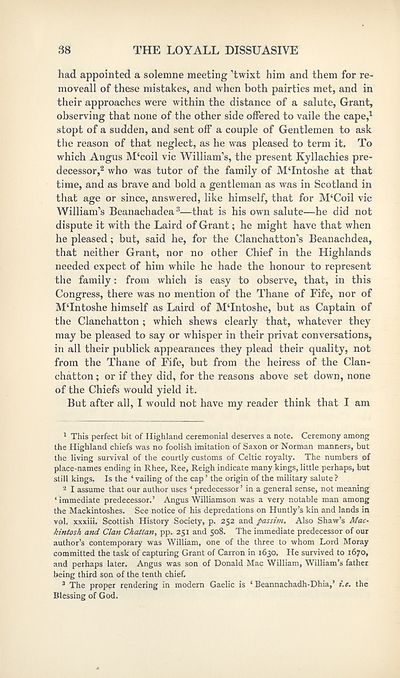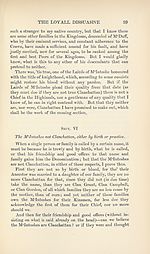Series 1 > Loyall dissuasive
(157) Page 38
Download files
Complete book:
Individual page:
Thumbnail gallery: Grid view | List view

38
THE LOYALL DISSUASIVE
had appointed a solemne meeting ’twixt him and them for re-
moveall of these mistakes, and when both pairties met, and in
their approaches were within the distance of a salute, Grant,
observing that none of the other side offered to vaile the cape,1
stopt of a sudden, and sent off a couple of Gentlemen to ask
the reason of that neglect, as he was pleased to term it. To
which Angus M‘coil vie William’s, the present Kyllachies pre¬
decessor,2 who was tutor of the family of M‘Intoshe at that
time, and as brave and bold a gentleman as was in Scotland in
that age or since, answered, like himself, that for M‘Coil vie
William’s Beanachadea 3—that is his own salute—he did not
dispute it with the Laird of Grant; he might have that when
he pleased; but, said he, for the Clanchatton’s Beanachdea,
that neither Grant, nor no other Chief in the Highlands
needed expect of him while he hade the honour to represent
the family: from which is easy to observe, that, in this
Congress, there was no mention of the Thane of Fife, nor of
MTntoshe himself as Laird of M‘Intoshe, but as Captain of
the Clanchatton ; which shews clearly that, whatever they
may be pleased to say or whisper in their privat conversations,
in all their publick appearances they plead their quality, not
from the Thane of Fife, but from the heiress of the Clan¬
chatton ; or if they did, for the reasons above set down, none
of the Chiefs would yield it.
But after all, I would not have my reader think that I am
1 This perfect bit of Highland ceremonial deserves a note. Ceremony among
the Highland chiefs was no foolish imitation of Saxon or Norman manners, but
the living survival of the courtly customs of Celtic royalty. The numbers of
place-names ending in Rhee, Ree, Reigh indicate many kings, little perhaps, but
still kings. Is the ‘ vailing of the cap5 the origin of the military salute ?
2 I assume that our author uses ‘predecessor’ in a general sense, not meaning
‘ immediate predecessor.’ Angus Williamson was a very notable man among
the Mackintoshes. See notice of his depredations on Huntly’s kin and lands in
vpl. xxxiii. Scottish History Society, p. 252 and passim. Also Shaw’s Mac¬
kintosh and Clan Chatlan, pp. 251 and 508. The immediate predecessor of our
author’s contemporary was William, one of the three to whom Lord Moray
committed the task of capturing Grant of Carron in 1630. He survived to 1670,
and perhaps later. Angus was son of Donald Mac William, William’s father
being third son of the tenth chief.
8 The proper rendering in modern Gaelic is ‘ Beannachadh-Dhia,’ i.c. the
Blessing of God.
THE LOYALL DISSUASIVE
had appointed a solemne meeting ’twixt him and them for re-
moveall of these mistakes, and when both pairties met, and in
their approaches were within the distance of a salute, Grant,
observing that none of the other side offered to vaile the cape,1
stopt of a sudden, and sent off a couple of Gentlemen to ask
the reason of that neglect, as he was pleased to term it. To
which Angus M‘coil vie William’s, the present Kyllachies pre¬
decessor,2 who was tutor of the family of M‘Intoshe at that
time, and as brave and bold a gentleman as was in Scotland in
that age or since, answered, like himself, that for M‘Coil vie
William’s Beanachadea 3—that is his own salute—he did not
dispute it with the Laird of Grant; he might have that when
he pleased; but, said he, for the Clanchatton’s Beanachdea,
that neither Grant, nor no other Chief in the Highlands
needed expect of him while he hade the honour to represent
the family: from which is easy to observe, that, in this
Congress, there was no mention of the Thane of Fife, nor of
MTntoshe himself as Laird of M‘Intoshe, but as Captain of
the Clanchatton ; which shews clearly that, whatever they
may be pleased to say or whisper in their privat conversations,
in all their publick appearances they plead their quality, not
from the Thane of Fife, but from the heiress of the Clan¬
chatton ; or if they did, for the reasons above set down, none
of the Chiefs would yield it.
But after all, I would not have my reader think that I am
1 This perfect bit of Highland ceremonial deserves a note. Ceremony among
the Highland chiefs was no foolish imitation of Saxon or Norman manners, but
the living survival of the courtly customs of Celtic royalty. The numbers of
place-names ending in Rhee, Ree, Reigh indicate many kings, little perhaps, but
still kings. Is the ‘ vailing of the cap5 the origin of the military salute ?
2 I assume that our author uses ‘predecessor’ in a general sense, not meaning
‘ immediate predecessor.’ Angus Williamson was a very notable man among
the Mackintoshes. See notice of his depredations on Huntly’s kin and lands in
vpl. xxxiii. Scottish History Society, p. 252 and passim. Also Shaw’s Mac¬
kintosh and Clan Chatlan, pp. 251 and 508. The immediate predecessor of our
author’s contemporary was William, one of the three to whom Lord Moray
committed the task of capturing Grant of Carron in 1630. He survived to 1670,
and perhaps later. Angus was son of Donald Mac William, William’s father
being third son of the tenth chief.
8 The proper rendering in modern Gaelic is ‘ Beannachadh-Dhia,’ i.c. the
Blessing of God.
Set display mode to:
![]() Universal Viewer |
Universal Viewer | ![]() Mirador |
Large image | Transcription
Mirador |
Large image | Transcription
Images and transcriptions on this page, including medium image downloads, may be used under the Creative Commons Attribution 4.0 International Licence unless otherwise stated. ![]()
| Scottish History Society volumes > Series 1 > Loyall dissuasive > (157) Page 38 |
|---|
| Permanent URL | https://digital.nls.uk/127548889 |
|---|
| Attribution and copyright: |
|
|---|
| Description | Over 180 volumes, published by the Scottish History Society, containing original sources on Scotland's history and people. With a wide range of subjects, the books collectively cover all periods from the 12th to 20th centuries, and reflect changing trends in Scottish history. Sources are accompanied by scholarly interpretation, references and bibliographies. Volumes are usually published annually, and more digitised volumes will be added as they become available. |
|---|


